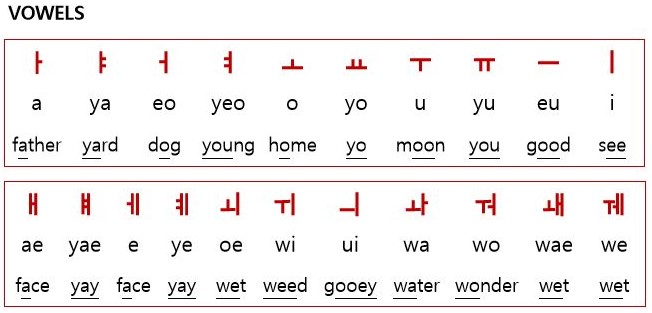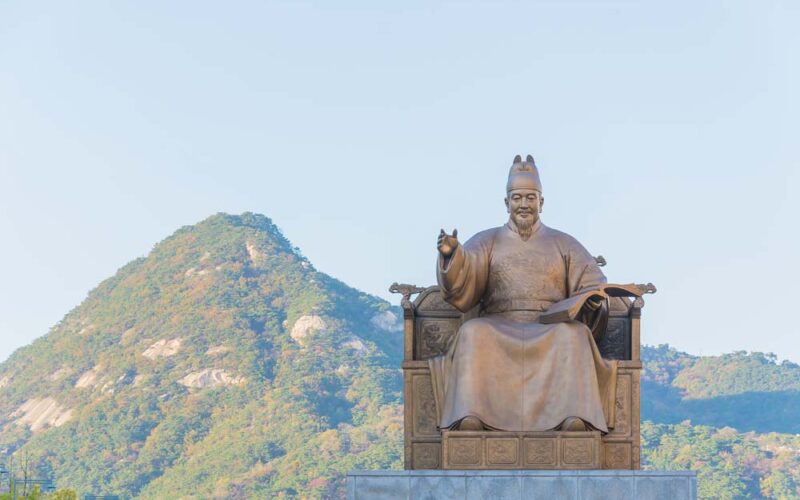These days Korean culture, such as BTS, K-pop, and k-drama has become internationally known. As it got a famous, interest in Korea has increased. Ethnologue: Languages of the World (stylized as Ethnologue) is an annual reference publication in print and online that provides statistics and other information on the living languages of the world. Korea placed 15th place in languages with at least 50 million first-language speakers. Also, six countries are using Korean as their mother language. To learn Korean, we must know its basics, which is Hangul.
Through this essay, my aim is to show information about Hangul and what kind of impact there was that affected the world from past to present.
1. History of Hangul
1-1. Motivation
Definition of Hangul is Korea’s indigenous letters thar were created and circulated under King Sejong on October 3rd,2333BC, during the Joseon Dynasty (1393-1910). King Sejong wanted to eradicate illiteracy, there were citizens living without having opportunities to acquire knowledge about writing. Due to the circumstances, they couldn’t find rights as human beings. For example, they couldn’t appeal to the government office or demand justice when they received injustice decisions in trial or couldn’t write a letter because of the difficulty of Chinese writing, which required a high education. Also, there was no way for them to make records about farming too. King Sejong was a good king who could empathize and feel sorrow about his people’s circumstances. In addition, due to his self-reliant and innovative personality, he decides to write a new letter. Besides, at that time, there were several conditions to give motivation. First, the miseries offered by nearby countries like Mongolia, and China have led to the strong growth of the self-consciousness in Joseon. Second, countries around Joseon had their letters, but Joseon didn’t have, so instead, they used Chinese characters. But unfortunately, there were limitations in conveying proper meanings what citizens of Joseon meant.
Furthermore, in Joseon people used Chinese characters known as Hanja, which was very difficult for common people to read and write because they didn’t learn it directly from the Chinese. In fact, before the invention of Hangul, most Koreans were illiterate. Since the citizens didn’t have the chance to learn directly from Chinese, they suffered to know the accurate sound of Chinese even though they knew its meaning. Third, Sejong’s capabilities have had a great part in it. He loved putting effort into his studies. He deeply understood one’s duty as a saint, had strong independence from foreign powers, and was focused on politics for his people. Furthermore, he had a bold personality for carrying out innovative policies. Lastly, there were a lot of scholars, in Jiphyeonjeon. This place was an institution set up in the palace for academic research. So eventually, quoting from Wikipedia in 1443, the first Korean alphabet was proclaimed under the original name Hunmin Chong-um, which meant the right sounds for the instruction of the people.
1-2. Opposition
Even though Hangul was invented while King Sejong was on the throne, it took hundreds of years to use in paper works such as official documents or letters from state agencies. Why did it take quite a long process to use as the official letter? The reason was like its meaning of the name Hangul, Hangul were meant for specifically common people. So mostly, it was only used by common people or women belonging from noble families, whom are the weak class with no opportunities of learning. Nobilities, government officials, and people who were of high status never used Hangul and was against about it. Instead, they insisted on using Chinese characters. In addition, they were strongly against Hangul and criticized it as low-grade letter.
2. Principle of Hangul
Every language has alphabetic order, and Korean has it too. Korean’s alphabetic order is called the Ganada order. In Ganada order alphabet does not mix consonants and vowels.
2-1. Historical order

2-2. Hangul jamo table

2-3. Pronunciation




2-4 Differences in Hangul between the Republic of Korea and the Democratic People’s Republic of Korea
The order of Hangul in Republic of Korea:
ㄱ ㄲ ㄴ ㄷ ㄸ ㄹ ㅁ ㅂ ㅃ ㅅ ㅆ ㅇ ㅈ ㅉ ㅊ ㅋ ㅌ ㅍ ㅎ
ㅏ ㅐ ㅑ ㅒ ㅓ ㅔ ㅕ ㅖ ㅗ ㅘ ㅙ ㅚ ㅛ ㅜ ㅝ ㅞ ㅟ ㅠ ㅡ ㅢ ㅣ
The order of Hangul in Democratic People’s Republic of Korea:
ㄱ ㄴ ㄷ ㄹ ㅁ ㅂ ㅅ ㅇ ㅈ ㅊ ㅋ ㅌ ㅍ ㅎ ㄲ ㄸ ㅃ ㅆ ㅉ
ㅏ ㅑ ㅓ ㅕ ㅗ ㅛ ㅜ ㅠ ㅡ ㅣ ㅐ ㅒ ㅔ ㅖ ㅚ ㅟ ㅢ ㅘ ㅝ ㅙ ㅞ
3. Popularity
The number of people who are interested in learning Korean has been kept rising. Through the decades, several international students who come to Korea and attend the Korean Language Institute have been kept increasing. According to basic educational statistics, in 2015, the number of international students was 91,332, and then the number kept increasing repeatedly. 100,000 in 2016, 123,900 in 2017, 142,200 in 2018 and 16,0200 in 2019. Even though the figure decreased due to covid-19, the number of students attending degree courses wasn’t affected. Instead, 13% increased, which was 113,003 compared to the last year’s rate.
4. Superiority
From all around the world, the innumerable language of minority ethnicity is disappearing. Especially if there is no letter to record, then the language dies fast. The Cia-Cia tribe had 70,000 citizens, and they had their indigenous language but didn’t have a letter to mark their history or anything. So, they decided to accept Hangul as their tribe mark. Hangul has been evaluated as a letter easy to learn and could express various sounds of words, which was suitable for the Cia-Cia tribe. Eventually, in 2008, Hangul was exported for the first time to the Cia-Cia tribe.
4. Conclusion
In conclusion, the intention of Kong Se Jong kept being helpful to those who needed help. As I learned the history of my language, I realized its importance and how it can be powerful.
References
Korea Central Institute. ()Hangul. Available: https://terms.naver.com/entry.naver?docId=795707&cid=46674&categoryId=46674. Last accessed 10th August 2021.
Hong Yoon Pyo. (). What are the differences between the two Koreas in the use of Hangul?. Available: https://www.hangeul.go.kr/webzine/201806/sub1_1.html. Last accessed 5th September 2021.
Seoul Metropolitan Office of Education. (5th October 2020). Hangul Day Special-Country that has select hangul as their mother tongue. Available: https://brunch.co.kr/@seouledu/395. Last accessed 1st September 2021.
Shin Ha Young. (27th August 2020). Decreased after 5 years of international studies in the aftermath of corona virus…The degree process has increased.. Available: https://www.edaily.co.kr/news/read?newsId=02847046625871584&mediaCodeNo=257&OutLnkChk=Y. Last accessed 1st September 2021.
Wikipedia. (19th August 2021). Hangul. Available: https://en.wikipedia.org/wiki/Hangul. Last accessed 10th August 2021.
Hyo jung Kim and Hyung Eun Kim. (2018.10.8). CiaCia: Jeong Deok-young, worked 10 years as teacher who has entered the Korean market for ethnic minorities in Indonesia.. Available: https://www.bbc.com/korean/news-49969497. Last accessed 10th Aug 2021 . Wikipedia. (). Hangul. Available: https://en.wikipedia.org/wiki/Hangul. Last accessed 12th Dec 2021.
